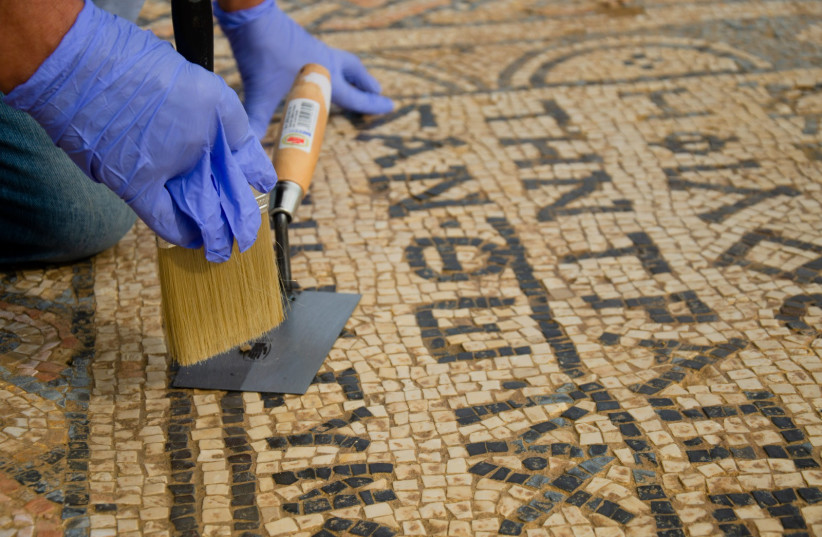A third century mosaic, discovered almost 20 years ago beneath the Megiddo Prison and believed to be the earliest one dedicated to Jesus, will soon be made available for public viewing with the expected relocation of the jail this June.
The mosaic was excavated between 2004 and 2008 in an Israel Antiquities Authority salvage dig ordered by the Israel Prison Service (IPS) before it began construction of a new prison wing. It is thought to have been part of an early Christian prayer house and includes a Greek inscription dedicated “to the God Jesus Christ.”
More than 60 prisoners from Megiddo and Tzalmon prisons participated in the dig.
The prison is slated to be relocated as early as June to allow archaeologists to make the mosaic accessible to tourists and allow for further investigation, the IAA has announced.
Two additional inscriptions were found on the mosaic and translated by Hebrew University Prof. Leah di Segni.
The inscription on the north side was dedicated to an army officer named Gaianos, who contributed the mosaic floor. The east inscription is dedicated to the memory of four women: Frimilia, Kiriaka, Dorothea and Karasta.
The name Akaptos is memorialized in the western inscription as “Lover of God who contributed the altar to the God Jesus Christos, as a memorial.”
Excavations at the site revealed a path inside the village with dwellings on both sides, noted Dr. Yotam Tepper, who led the salvage dig and is now the IAA’s central region academic consultant.
The large building with the Christian prayer hall was located on the northwest side of the path, and another large building was on the south side.
Tepper hopes to be able to continue researching the buildings when he is able to renew the excavations.
Finds from the site area – including remains from a Roman period Jewish village having both Jewish and Samaritan residents, a Roman army legion camp and a Roman-Byzantine city – indicate the presence of diverse cultural, religious and ethnic population groups, he said.
Archaeological evidence also points to an early Christian community – whose members included Roman army officers – and tells the story of Christianity before it became the official religion of the empire.
“There was an early Christian community here way before Christianity became the official religion,” Tepper said. “Through the excavations, we learned about all the connections between Samaritans, Jews, pagans, Christians, soldiers and civilians: It is a microcosm.
“To have neighborhoods of so many different religions and ethnicities in such geographical proximity to each other makes this very special.”
Archaeological evidence points toward good neighborly relations, he said.
“We see their houses next to each other, which points to a good relationship,” Tepper said. “Of course I don’t know what they said to one another. “Because of the presence of different religions here it is a very interesting place to excavate and learn about the relations between the different religions… it can be a very important contribution to our knowledge.”
Interestingly, he said, when the Romans left the site, they purposefully covered the mosaic with a protective layer of roof tiles and large sections of wall plaster. The building shows no sign of destruction and, though they found remains from the fourth century in other parts of the village, it appears that nobody re-inhabited the Christian building or made use of it in any way. This could point to continued Roman ownership of the property, the dig leader said.
“The building was abandoned and nobody lived there again,” Tepper said. “Usually when people leave, others use the building, but here that did not happen.”
There had already been talk of moving the prison over a decade ago during the excavations. Last week, representatives from the IAA, the IPS and the Megiddo Regional Council toured the area to discuss the move.
“I am ready to begin excavating again,” Tepper said. “It is a challenge and I am very curious to see what we discover – I will be very happy to return.”

